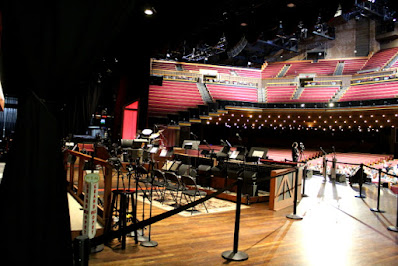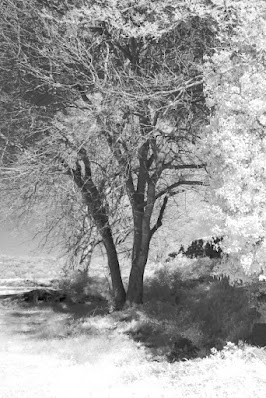 |
| Picture by Kolohe |
When I saw that Southwest Airlines was offering non-stop "Wanna Get Away" flights from Las Vegas to Nashville, I decided it was time for a RonnieAdventure to Tennessee and beyond.
A visit to the Grand Ole Opry (Nashville's number one attraction) had been on my Bucket List for a long time. The Opry made its first broadcast on WSM radio station from the National Life Building in Nashville on November 28, 1925. The broadcast was originally called "The WSM Barn Dance," but the program name was changed to "Grand Ole Opry" in 1927. The broadcast was so popular that in 1932 WSM built the world's tallest radio tower and the station boosted its power so that the Opry could be received from New York to California, plus parts of Canada and Mexico. In 1947 the Opry moved to the historic Ryman Auditorium in downtown Nashville, where it remained for 31 years.
In 1974 the 4,400-seat Grand Ole Opry House ("Home of American Music") was built on the east side of Nashville, north of the airport. The first performance broadcasted from the Opry House was on March 15, 1974. The next night President Richard Nixon appeared on stage with Roy Acuff, "The King of Country Music." Grand Ole Opry is now the longest running program in broadcast history.
The Opry helped launch countless careers for many country music greats, including Johnny Cash, June Carter, Minnie Pearl, Ernest Tubb, Roy Acuff, Bill Monroe, Loretta Lynn, and Dolly Parton. The program is broadcast live on WSM Radio and around the world on Circle TV and Circle One Demand. Most of the program dialog is unscripted, so it is unpredictable what performing artists will say or what will happen on each show. The program's motto is "Play it loose, make it fun, honor the music, and whatever happens onstage, roll with it."
The "Opry Country Classic" show was performed the night we visited the Opry.. Our printed program said that the show was hosted by Larry Gatlin and appearing in the show would be The Gatlin Brothers, Elizabeth Cook, and Maggie Rose.
Since the program is broadcast live, at exactly 7:00 PM a red neon sign above the stage started flashing "On Air" and the audience started screaming and going wild. Announcer Bill Cody welcomed everyone to the Opry and told us that today was Loretta Lynn's 90th birthday, so tonight's show would be dedicated to her. Cody said that due to health reasons, Lynn could not be in attendance; however, he said that we were in for a special treat because there were going to be some surprises in the show.
 |
| Bill Cody (Picture by Kolohe) |
The Gatlin brothers played a few songs, told some stories, and then introduced Elizabeth Cook.
 |
| Larry Gatlin (Picture by Kolohe) |
 |
| Elizabeth Cook (Picture by Kolohe) |
 |
| Picture by Kolohe |
Following Cook, Loretta Lynn's Granddaughter, Tayla, came on stage and sang a few songs for Loretta. After she finished, Conway Twitty's grandson, Tre, joined Tayla in a duet. Next, Loretta's sisters, Peggy and Crystal, joined in the celebration. All of these people are well known country music artist. The program closed with two songs by Maggie Rose.
 |
| Tayla (Picture by Kolohe) |
 |
| Tre and Tayla (Picture by Kolohe) |
 |
| Peggy, Tayla and Crystal (Picture by Kolohe) |
 |
| Maggie Rose (Picture by Kolohe) |
After the show, we were able to arrange for a tour of the Opry House backstage. Although not visible from first floor seating, imbedded in the center of the stage is a six-foot circle of wood from the Ryman Auditorium. It was placed there to remind everyone of the 31-year history associated with broadcasting from that location.
 |
| Picture by Kolohe |
 |
| Picture by Kolohe |
 |
| Picture by Kolohe |
The Jimmy Capps room is dedicated to one of the greatest county music guitar players of all times. He performed onstage for 61 years and at the height of his career he completed over 500 recording sessions each year.
It was interesting when we learned about the Nashville Number System, which is a method that musicians use to figure out chord progressions on the fly. The method transcribes music by denoting the scale degree on which a chord is built. Using this system, the Opry band usually only practices a song with the performing artist once or twice before the program. The system was developed in the 1950's by Neal Matthews for the Jordanaires and in 1988 the information was compiled and published in a book by Chas Williams.

Becoming a member of the Grand Ole Opry is considered to be one of country music's highest achievements. Membership is very limited and by invitation only. An invitation to become an Opry member is made to a musician by an active member during a live broadcast, usually in the Opry House. Since inception of the Opry in the 1920s, there have only been 219 members. Currently there are 67 living members, including seven of whom have retired from performing. Backstage there is a "Wall of Fame" of all members and each active member has their own post office box for fan mail.
 |
| Picture by Kolohe |
We were surprised at the large number of dressing rooms backstage. There are a total of 18 dressing rooms and each room has its own decor.
 |
| Picture by Kolohe |
 |
| Picture by Kolohe |
 |
| Picture by Kolohe |
 |
| Picture by Kolohe |
 |
| Picture by Kolohe |
 |
| Picture by Kolohe |
 |
| Picture by Kolohe |
 |
| Picture by Kolohe |
Throughout the backstage area there are various displays of members' hats, shoes, and dresses.
 |
| Picture by Kolohe |
 |
| Picture by Kolohe |
 |
| Picture by Kolohe |
 |
| Picture by Kolohe |
During the devastating Nashville Flood of May 1, 2010, the Opry House was completely flooded and a brown high water line can still be seen on the famous Archie Campbell painting located backstage. During the five months it took to refurbish the Opry house, broadcasting of the show was from the Ryman Auditorium and other nearby facilities.
The Hee Haw TV program was filmed in a sound studio that is attached to the Opry House. The studio is still used for filming and special events.
 |
| Picture by Kolohe |
When leaving the facility, we were warned that the speed limit is strictly enforced.
Historic Fort Negley
The Union Army defeated the Confederates on February 25, 1862, at the Battle of Nashville, and immediately built Fort Negley atop St. Cloud Hill. This was considered to be a strategic location because it overlooked the Cumberland River and there was a network of railroads in the area.
Fort Negley was the largest inland stone fort built during the Civil War and it was so well fortified that it was never attacked.
There is a hiking trail that runs around the hill just below the fort walls and a trail leading up to the Fort's main gate on the north side of the property. From the top of the hill there are great views of downtown Nashville and the surrounding area.
 |
| Picture by Kolohe |
 |
| Picture by Kolohe |
 |
| Picture by Kolohe |
 |
| Picture by Kolohe |
 |
| Picture by Kolohe |
Bonus Pictures by Kolohe























































